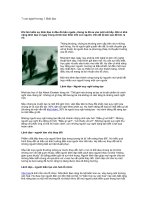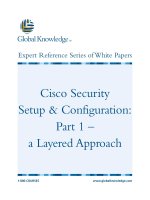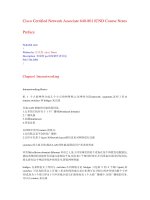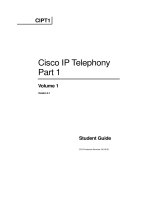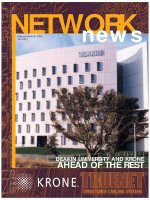Tài liệu Cisco TelePresence Network Systems 1.1 Design Guide pdf
Bạn đang xem bản rút gọn của tài liệu. Xem và tải ngay bản đầy đủ của tài liệu tại đây (3.93 MB, 138 trang )
Cisco TelePresence Network Systems 1.1
Design Guide
Cisco Validated Design
March 7, 2008
Cisco Validated Designs for deploying point-to-point Cisco TelePresence 1000
and 3000 systems in enterprise campus and branch, WAN, and VPN
networks.
Americas Headquarters
Cisco Systems, Inc.
170 West Tasman Drive
San Jose, CA 95134-1706
USA
Tel: 408 526-4000
800 553-NETS (6387)
Fax: 408 527-0883
Customer Order Number: OL-14133-01
Cisco Validated Design
The Cisco Validated Design Program consists of systems and solutions designed, tested, and
documented to facilitate faster, more reliable, and more predictable customer deployments. For more
information visit www.cisco.com/go/validateddesigns.
ALL DESIGNS, SPECIFICATIONS, STATEMENTS, INFORMATION, AND RECOMMENDATIONS (COLLECTIVELY,
"DESIGNS") IN THIS MANUAL ARE PRESENTED "AS IS," WITH ALL FAULTS. CISCO AND ITS SUPPLIERS DISCLAIM
ALL WARRANTIES, INCLUDING, WITHOUT LIMITATION, THE WARRANTY OF MERCHANTABILITY, FITNESS FOR A
PARTICULAR PURPOSE AND NONINFRINGEMENT OR ARISING FROM A COURSE OF DEALING, USAGE, OR TRADE
PRACTICE. IN NO EVENT SHALL CISCO OR ITS SUPPLIERS BE LIABLE FOR ANY INDIRECT, SPECIAL,
CONSEQUENTIAL, OR INCIDENTAL DAMAGES, INCLUDING, WITHOUT LIMITATION, LOST PROFITS OR LOSS OR
DAMAGE TO DATA ARISING OUT OF THE USE OR INABILITY TO USE THE DESIGNS, EVEN IF CISCO OR ITS SUPPLIERS
HAVE BEEN ADVISED OF THE POSSIBILITY OF SUCH DAMAGES.
THE DESIGNS ARE SUBJECT TO CHANGE WITHOUT NOTICE. USERS ARE SOLELY RESPONSIBLE FOR THEIR
APPLICATION OF THE DESIGNS. THE DESIGNS DO NOT CONSTITUTE THE TECHNICAL OR OTHER PROFESSIONAL
ADVICE OF CISCO, ITS SUPPLIERS OR PARTNERS. USERS SHOULD CONSULT THEIR OWN TECHNICAL ADVISORS
BEFORE IMPLEMENTING THE DESIGNS. RESULTS MAY VARY DEPENDING ON FACTORS NOT TESTED BY CISCO.
CCIP, CCSP, the Cisco Arrow logo, the Cisco Powered Network mark, Cisco Unity, Follow Me Browsing, FormShare, and StackWise are trademarks of Cisco Systems, Inc.;
Changing the Way We Work, Live, Play, and Learn, and iQuick Study are service marks of Cisco Systems, Inc.; and Aironet, ASIST, BPX, Catalyst, CCDA, CCDP, CCIE, CCNA,
CCNP, Cisco, the Cisco Certified Internetwork Expert logo, Cisco IOS, the Cisco IOS logo, Cisco Press, Cisco Systems, Cisco Systems Capital, the Cisco Systems logo,
Empowering the Internet Generation, Enterprise/Solver, EtherChannel, EtherSwitch, Fast Step, GigaStack, Internet Quotient, IOS, IP/TV, iQ Expertise, the iQ logo, iQ Net
Readiness Scorecard, LightStream, MGX, MICA, the Networkers logo, Networking Academy, Network Registrar, Packet, PIX, Post-Routing, Pre-Routing, RateMUX, Registrar,
ScriptShare, SlideCast, SMARTnet, StrataView Plus, Stratm, SwitchProbe, TeleRouter, The Fastest Way to Increase Your Internet Quotient, TransPath, and VCO are registered
trademarks of Cisco Systems, Inc. and/or its affiliates in the U.S. and certain other countries.
All other trademarks mentioned in this document or Web site are the property of their respective owners. The use of the word partner does not imply a partnership relationship
between Cisco and any other company. (0304R)
Cisco TelePresence Network Systems 1.1 Design Guide
Copyright © 2007 Cisco Systems, Inc. All rights reserved.
CONTENTS
CHAPTER
1
Cisco TelePresence Solution Overview
Cisco TelePresence System 3000
1-1
Cisco TelePresence System 1000
1-1
1-2
Cisco TelePresence Codecs
1-3
Industry-Leading Audio and Video Support 1-5
Video Resolutions and Compression Formats 1-5
Resolution 1-5
Frame Rate 1-6
Compression 1-6
Audio Resolution and Compression Formats 1-6
Frequency Spectrum 1-7
Spatiality 1-7
Compression 1-7
Cisco TelePresence Manager
1-8
Cisco Unified 7970G IP Phone
1-9
Cisco TelePresence Multipoint Solutions
Cisco TelePresence Virtual Agent
CHAPTER
2
Connecting the Endpoints
Overview
1-10
2-1
2-1
Connecting a CTS-1000 System
2-1
Connecting a CTS-3000 System
2-2
Cisco TelePresence Network Interaction
CHAPTER
3
1-10
2-4
TelePresence Network Deployment Models
Introduction
3-1
3-1
Intra-Campus Deployment Model
3-1
Intra-Enterprise Deployment Model
Cisco Powered Networks 3-3
Point-to-Point versus Multipoint
3-2
3-3
Inter-Enterprise/Business-to-Business Deployment Model
3-4
Cisco TelePresence Network Systems 1.1 Design Guide
OL-14133-01
iii
Contents
Hosting and Management Options
3-5
TelePresence Phases of Deployment
CHAPTER
4
3-5
Quality of Service Design for TelePresence
Overview
4-1
4-1
Defining the Strategic Business Objective for QoS for TelePresence
Analyzing the Service Level Requirements of TelePresence
TelePresence Bandwidth Requirements 4-3
Burst Requirements 4-5
TelePresence Latency Requirements 4-5
TelePresence Jitter Requirements 4-7
TelePresence Loss Requirements 4-8
4-2
4-3
Tactical QoS Design Best Practices for TelePresence 4-10
Relevant Industry Standards and Recommendations 4-11
RFC 2474 Class Selector Code Points 4-11
RFC 2597 Assured Forwarding Per-Hop Behavior Group 4-11
RFC 3246 An Expedited Forwarding Per-Hop Behavior 4-11
RFC 3662 A Lower Effort Per-Domain Behavior for Differentiated Services
Cisco’s QoS Baseline 4-12
RFC 4594 Configuration Guidelines for DiffServ Classes 4-12
Classifying TelePresence 4-15
Policing TelePresence 4-16
Queuing TelePresence 4-17
Shaping TelePresence? 4-18
Compressed RTP (cRTP) with TelePresence 4-18
Link Fragmentation and Interleaving (LFI) with TelePresence 4-19
GRE/IPSec Tunnels with TelePresence 4-19
Place in the Network TelePresence QoS Design
CHAPTER
5
Campus QoS Design for TelePresence
Overview
4-11
4-19
5-1
5-1
Access Edge Switch Port QoS Considerations
Campus Inter-Switch Link QoS Considerations
5-1
5-5
TelePresence Campus Access-Layer QoS Designs 5-6
Catalyst 3560G/3750G and 3650-E/3750E 5-7
Catalyst 4500 and 4948 5-13
Catalyst 6500 5-17
Ingress Queuing Design—1Q2T 5-20
Cisco TelePresence Network Systems 1.1 Design Guide
iv
OL-14133-01
Contents
Egress Queuing Design—1P2Q2T
Egress Queuing Design—1P3Q8T
5-21
5-22
Distribution and Core QoS Considerations and Design
CHAPTER
6
Branch QoS Design for TelePresence
6-1
TelePresence Branch QoS Design Overview
LLQ versus CBWFQ Considerations
5-24
6-1
6-1
Campus WAN/VPN Block Considerations
6-7
TelePresence Branch LAN Edge 6-8
TelePresence Branch LAN Edge QoS Design Considerations
TelePresence Branch LAN Edge QoS Designs 6-11
6-8
TelePresence Branch WAN Edge 6-11
TelePresence Branch WAN Edge Design Considerations 6-11
TelePresence Branch WAN Edge QoS Design 6-11
TelePresence Branch WAN Edge LLQ Policy 6-11
TelePresence Branch WAN Edge CBWFQ Policy 6-14
TelePresence Branch T3/DS3 WAN Edge Design 6-14
TelePresence Branch OC3-POS WAN Edge Design 6-18
TelePresence Branch IPSec VPN Edge 6-22
TelePresence Branch IPSec VPN Edge Considerations 6-22
TelePresence Branch IPSec VPN Edge QoS Design 6-24
TelePresence Branch MPLS VPN 6-26
TelePresence Branch MPLS VPN Edge Considerations 6-27
TelePresence Branch MPLS VPN QoS Designs 6-32
TelePresence 4-Class MPLS VPN SP Model QoS Design 6-32
TelePresence 6-Class MPLS VPN SP Model QoS Design 6-37
TelePresence Sub-Line Rate Ethernet Access QoS Designs 6-39
CHAPTER
7
Call Processing Overview
Overview
7-1
7-1
Call Processing Components
7-1
TelePresence Endpoint Interface to CUCM (Line-Side SIP)
7-3
TelePresence Multipoint Switch Interface to CUCM (Trunk-Side SIP)
TelePresence Endpoint Device Registration
Call Setup 7-4
Call Teardown 7-7
Firewall and NAT Considerations
7-3
7-4
7-8
Cisco TelePresence Network Systems 1.1 Design Guide
OL-14133-01
v
Contents
CHAPTER
8
Capacity Planning and Call Admission Control
Overview
8-1
Manual Capacity Planning
CHAPTER
9
8-1
Call Processing Deployment Models
Overview
8-1
9-1
9-1
Dial-Plan Recommendations
9-1
Single-Site Call Processing Model
Call Admission Control 9-3
9-2
Multi-Site WAN with Centralized Call Processing Model
Call Admission Control 9-4
9-4
Cisco TelePresence Network Systems 1.1 Design Guide
vi
OL-14133-01
C H A P T E R
1
Cisco TelePresence Solution Overview
The Cisco TelePresence suite of virtual meeting solutions consists of the products and capabilities
described in the following sections.
Cisco TelePresence System 3000
The Cisco TelePresence System 3000 (CTS-3000) is designed for large group meetings, seating up to 12
participants around a virtual table. It consists of:
•
Three 65” high definition plasma displays
•
Three high definition cameras
•
Three wide band microphones and speakers
•
A lighting shroud integrated around a purpose built meeting room table
Customers must furnish their own chairs. A Cisco 7970G IP phone is used to launch, control, and end
the meeting.
Cisco TelePresence Network Systems 1.1 Design Guide
OL-14133-01
1-1
Chapter 1
Cisco TelePresence Solution Overview
Cisco TelePresence System 1000
Figure 1-1
Cisco TelePresence System 3000
Participants are displayed life size with two participants per screen/table segment and multi-channel,
discrete, full-duplex audio with echo cancellation per channel that appears to emanate from the person
speaking. The unique table design also provides power and Ethernet ports in each table leg, so users do
not have to hunt for power and network connections during the meeting. A projector is integrated under
the middle section of the table for convenient viewing of PC graphics on the panel below the plasma
displays. An optional WolfVision® document camera (not shown) may be installed in the ceiling so that
objects and documents placed on the table surface may be viewed as well.
The CTS-3000 is represented by the icon in Figure 1-2.
Figure 1-2
CTS-3000 Icon
Cisco TelePresence System 1000
The Cisco TelePresence System 1000 (CTS-1000) is designed for smaller executive meeting room
environments and one-on-one conversations, seating up to four participants at a virtual table. It consists
of:
•
One 65” high definition plasma display
•
One high definition camera
•
One wide band microphone and speaker
Cisco TelePresence Network Systems 1.1 Design Guide
1-2
OL-14133-01
Chapter 1
Cisco TelePresence Solution Overview
Cisco TelePresence Codecs
•
A lighting shroud integrated over the display
The customer must furnish their own meeting room table and chairs. A Cisco 7970G IP phone is used to
launch, control, and end the meeting.
Figure 1-3
Cisco TelePresence System 1000
Participants are displayed life size with two participants per screen/table segment and full-duplex audio
with echo cancellation that appears to emanate from the person speaking. An optional NEC® LCD
display (not shown) may be installed on the table or on the wall for convenient viewing of PC graphics.
An optional WolfVision® document camera (not shown) may be installed on the table so that objects and
documents placed on the table surface may be viewed as well.
The CTS-1000 is represented by the icon in Figure 1-4.
Figure 1-4
CTS-1000 Icon
Cisco TelePresence Codecs
One of the goals of Cisco TelePresence is to hide the technology from the user so that participants
experience the meeting, not the technology. Hidden underneath the plasma displays in both the
CTS-3000 and CTS-1000 solutions are the Cisco TelePresence Codecs. The CTS-3000 consists of one
primary Codec and two secondary Codecs. The CTS-1000 consists of a single primary Codec.
Cisco TelePresence Network Systems 1.1 Design Guide
OL-14133-01
1-3
Chapter 1
Cisco TelePresence Solution Overview
Cisco TelePresence Codecs
Figure 1-5
Cisco TelePresence Codec
The Codec is the engine which drives the entire Cisco TelePresence solution. All displays, cameras,
microphones, and speakers connect to it and it communicates with the network and handles all audio and
video processing. The Codec runs a highly-integrated version of the Linux operating system on an
embedded Compact Flash module and is managed via Secure Shell (SSH), Hyper-Text Transfer Protocol
over Secure Sockets Layer (HTTPs) and Simple Network Management Protocol (SNMP). These Codecs
make the Cisco TelePresence solutions an integrated part of Cisco Unified Communications by
leveraging established techniques for network automation and Quality of Service (QoS), such as:
•
Cisco Discovery Protocol (CDP) and 802.1Q for discovery and assignment to the appropriate Virtual
LAN (VLAN).
•
802.1p and Differentiated Services Code Point (DSCP) for QoS.
•
Automated provisioning of configuration and firmware from Cisco Unified Communications
Manager.
•
Session Initiation Protocol (SIP) for all call signaling communications.
From an administrator’s perspective, the entire Cisco TelePresence virtual meeting room appears as a
single SIP endpoint on Cisco Unified Communications Manager. It is managed using tools and
methodologies that are similar to those used for Cisco Unified IP Phones.
The Cisco TelePresence Codec is represented by the icon in Figure 1-6.
Figure 1-6
Cisco TelePresence Codec Icon
Primary
Cisco TelePresence Network Systems 1.1 Design Guide
1-4
OL-14133-01
Chapter 1
Cisco TelePresence Solution Overview
Industry-Leading Audio and Video Support
Industry-Leading Audio and Video Support
Cisco TelePresence utilizes industry-leading 1080p high-definition video resolution and 48kHz
wide-band spatial audio. 720p high-definition is also supported for sites with restricted bandwidth
availability.
Video Resolutions and Compression Formats
The Cisco TelePresence 65” displays and cameras natively support 1080p resolution and utilize digital
media interfaces to connect to the Cisco TelePresence Codecs. This ensures the integrity of the video
signal from end to end by eliminating the need for any digital/analog conversion.
Inside the Cisco TelePresence Codecs an onboard array of Digital Signal Processors (DSPs) encode the
digital video signal from the cameras into Real-Time Transport Protocol (RTP) packets using the H.264
encoding and compression standard. The Cisco TelePresence Codecs can encode the video from the
cameras at 1080p or 720p.
The quality of the video enjoyed by the meeting participants is a function of three variables:
•
Resolution (i.e., number of pixels within the image)
•
Frame rate (how often those pixels are re-drawn on the display)
•
Degree of compression applied to the original video signal
Resolution
1080p provides the highest quality video image currently available on the market, supplying a resolution
of 1920 x 1080 and 2,074,000 pixels per frame. 720p provides a resolution of 1280 x 720 and 922,000
pixels per frame. Compared with today’s DVD standard video (480p) with a resolution of 720 x 480 and
338,000 pixels per frame, you can see the dramatic increase in resolution and pixel count. Figure 1-7
illustrates the difference between these three resolutions.
0
480
720
1080
Video Resolutions
720
1280
1920
DVD (480p)
338,000 pixels
720p
922,000 pixels
1080p
2,074,000 pixels
220317
Figure 1-7
Cisco TelePresence Network Systems 1.1 Design Guide
OL-14133-01
1-5
Chapter 1
Cisco TelePresence Solution Overview
Industry-Leading Audio and Video Support
Frame Rate
The frame rate of the displayed video directly corresponds to how motion within the video is perceived
by the participants. To maintain excellent motion handling, the Cisco TelePresence System encodes
video at from the cameras at 30 frames per second (30fps or 30Hz). In addition, the codec video output
signal to the 65” plasma displays utilizes progressive-scan technology to refresh the pixels at 60 fields
per second (60Hz). This is twice as fast as traditional television and video conferencing equipment which
utilize an interlaced refresh format.
Compression
Note that 1080p video uncompressed is approximately 1.5 Gbps. The Cisco TelePresence Codecs must
take this native video received from the cameras and compress it to a more feasible bandwidth value in
as little time as possible. As mentioned above, they achieve this by utilizing an array of DSPs to
compress the original 1.5 Gbps video from each camera down to under 4 Mbps (per camera),
representing a compression ratio of over 99%, and they achieve this in under 90ms. To provide maximum
flexibility, the customer is provided with some amount of control over how much compression is applied.
For each of the two resolution formats supported (1080p and 720p), the Cisco TelePresence System
supports three quality levels. Each quality level is really a function of the degree of compression applied,
and has a corresponding bandwidth value. For simplicity, these three levels are referred to as “good,”
“better,” and “best.” The “best” quality level has the least amount of compression applied and therefore
requires the most bandwidth, while the “good” quality level has the most amount of compression applied
and requires the least amount of bandwidth.
Taking the three variables described above—resolution, frame rate, and the degree of compression
applied—Table 1-1 illustrates the different quality settings supported by the Cisco TelePresence System
and the requisite bandwidth required for each quality setting.
Table 1-1
Resolution, Quality, and Bandwidth Settings Supported (Video Only)
Resolution
1080p
720p
Quality Level
Best
Better
Good
Best
Better
Good
Frame Rate
30
30
30
30
30
30
Bandwidth Required
4Mbps
3.5Mpbs
3Mpbs
3Mpbs
2Mpbs
1Mpbs
These bandwidth values apply per camera. Therefore, a CTS-3000 which has three cameras and three
displays, running at 1080p resolution at the “best” quality level, requires 12Mbps of video bandwidth,
whereas a CTS-1000 requires 4Mbps of video bandwidth. These bandwidth values do not include the
audio channels or the auxiliary video channel for displaying PC graphics and document camera images.
Therefore, a more complete bandwidth table is Table 4-1.
Audio Resolution and Compression Formats
The Cisco TelePresence System utilizes advanced microphone, speaker, and audio encoding
technologies to preserve the quality and directionality of the audio so that it appears to emanate from the
location of the person speaking at the same volume as it would be heard if that person were actually
sitting across the table from you. Specifically, wideband spatial audio and multi-channel, full-duplex
Cisco TelePresence Network Systems 1.1 Design Guide
1-6
OL-14133-01
Chapter 1
Cisco TelePresence Solution Overview
Industry-Leading Audio and Video Support
sound provides excellent voice projection and helps enable multiple simultaneous conversations, just
like what typically occurs during an in-person meeting. Specially designed microphones eliminate sound
interference.
The quality of the audio enjoyed by the meeting participants is a function of three variables:
•
Frequency spectrum and decibel levels captured by the microphones
•
Spatiality (i.e., directionality) of the audio
•
Degree of compression applied to the original audio signal
Frequency Spectrum
The Cisco TelePresence microphones are designed to capture a 48kHz frequency spectrum of audio in a
directional pattern that focuses on the people sitting directly in front of it and are geared to the decibel
levels of human speech. Filters are designed into the microphones to eliminate interference from GSM
and GPRS cellular signals and to eliminate certain frequencies generated by machinery such as the fans
found in laptop computers and Heating, Ventilation, and Air Conditioning (HVAC) systems. Echo
cancellation technology is built into the Cisco TelePresence Codec to eliminate cross-talk and
double-talk.
The Cisco TelePresence speakers are designed to reproduce the same rich frequency spectrum and
decibel level of human speech.
Spatiality
To preserve the spatiality (i.e., directional perception) of the audio, the CTS-3000 employs three
individual microphones placed at specific locations of the virtual table, along with three individual
speakers located under each display.
Compression
Inside the Cisco TelePresence Codecs an onboard array of DSPs encode the audio signal from the
microphones into RTP packets using the Advanced Audio Coding-Low Delay (AAC-LD) encoding and
compression standard. The resulting bandwidth required to transport the audio signals between the
systems is 64kbps per microphone. Therefore, a CTS-3000 which has three microphones and speakers
requires 192kbps of audio bandwidth, whereas the CTS-1000 requires 64kbps of audio bandwidth. Note
that the Cisco TelePresence System also supports a fourth auxiliary audio channel which is used to
transmit audio from a PC (used in conjunction with the projector when displaying PC graphics) or from
an audio-only participant which is conferenced into the meeting using the Conference/Join softkey on
the Cisco 7970G IP Phone (also known as the Audio Add-In feature). Therefore, a CTS-3000 can
transmit and receive up to 256kbps of audio, as detailed in Table 4-1. The CTS-1000 transmits up to
128kbps of audio, but can receive up to 256kbps when participating in a meeting with a CTS-3000 (in
such a configuration, the CTS-1000 receives three separate [64 kbps] primary audio streams from the
CTS-3000, as well as a potentially additional [64 kbps] auxiliary audio stream).
Cisco TelePresence Network Systems 1.1 Design Guide
OL-14133-01
1-7
Chapter 1
Cisco TelePresence Solution Overview
Cisco TelePresence Manager
Cisco TelePresence Manager
Cisco TelePresence Manager (CTSMGR) simplifies the scheduling and management of Cisco
TelePresence virtual meeting room solutions. CTSMGR is a Linux-based appliance running on a Cisco
7800 Series Media Convergence Server platform. It is the middleware glue between Cisco Unified
Communications Manager, the Cisco TelePresence meeting rooms, and the customer’s groupware
calendaring and scheduling application (e.g., Microsoft Exchange/Outlook).
Figure 1-8
Cisco TelePresence Manager
CTSMGR collects information about Cisco TelePresence systems from Cisco Unified Communications
Manager and associates those systems to their physical location or conference room as defined in the
customer's Microsoft Active Directory and Microsoft Exchange.1 This allows users to schedule Cisco
TelePresence meetings using their Microsoft Outlook group calendar and have that schedule
automatically sent to the Cisco TelePresence systems involved in the call. Hence users can launch the
Cisco TelePresence call with the push of one button, by simply selecting their meeting from the list of
meetings shown on the Cisco Unified 7970G IP phone in the meeting room.
CTSMGR is managed via SSH, HTTPs, and SNMP. From an administrator’s perspective, CTSMGR is
managed using tools and methodologies that are similar to those used with a Cisco Unified
Communications Manager server.
CTSMGR communicates with Cisco Unified Communications Manager using Application XML
Layer/Simple Object Access Protocol (AXL/SOAP) and Computer Telephony Integration/Quick Buffer
Encoding (CTI/QBE).
CTSMGR communicates with Microsoft Active Directory and Microsoft Exchange using Light-Weight
Directory Access Protocol (LDAP) and Web-Based Distributed Authoring and Versioning (WebDAV)
standards.
1. In its first release, Cisco TelePresence Manager supports Microsoft Active Directory 2000 or 2003 and
Microsoft Exchange 2003. Other directory services and groupware applications are planned for a future
release.
Cisco TelePresence Network Systems 1.1 Design Guide
1-8
OL-14133-01
Chapter 1
Cisco TelePresence Solution Overview
Cisco Unified 7970G IP Phone
CTSMGR communicates with the Cisco TelePresence Systems using eXtensible Markup
Language/Simple Object Access Protocol (XML/SOAP).
Figure 1-9
Cisco TelePresence Manager Connectivity
Microsoft
Active Directory
LDAP
AXL/SOAP
WebDAV
M
Cisco Unified
CallManager
Cisco
TelePresence
System Manager
Microsoft
Exchange
XML/SOAP
Cisco
TelePresence
System
221632
Primary
Cisco Unified 7970G IP Phone
To further enhance the meeting participants’ experience of the meeting, cumbersome hand-held remote
controls are eliminated, the cameras are fixed in their positions (no panning, tilting, or zooming
controls), and the microphones are fixed in their positions on the table. There are virtually no moving
parts or user interfaces that users must master to use a Cisco TelePresence meeting room.
Rather, the Cisco TelePresence meeting room solutions use a Cisco Unified 7970G IP phone,
conveniently located on the table, to launch, control, and conclude meetings. This makes Cisco
TelePresence as easy to use as a telephone. Using the high-resolution touch-screen display of the Cisco
Unified 7970G IP phone, the user simply dials the telephone number of the Cisco TelePresence room
with which they wish to have a meeting and the call is connected. Softkey menu buttons on the phone
allow the user to place the call on hold or conference in an audio-only participant. When used in
conjunction with Cisco TelePresence Manager, the schedule of meetings for the day are displayed on the
phone and the user simply touches the appropriate location on the screen to launch that scheduled
meeting.
Cisco TelePresence Network Systems 1.1 Design Guide
OL-14133-01
1-9
Chapter 1
Cisco TelePresence Solution Overview
Cisco TelePresence Multipoint Solutions
Figure 1-10
Cisco Unified 7970G IP Phone
Cisco TelePresence Multipoint Solutions
To enable Cisco TelePresence meetings between more than two rooms, a Cisco TelePresence Multipoint
Switch (CTMS) is required. The Cisco TelePresence Multipoint Switch is a purpose-built Linux-based
appliance running on a Cisco 7800 Series Media Convergence Server platform. It provides
high-capacity, low-latency multipoint switching for Cisco TelePresence only.
The CTMS is represented by the icon in Figure 1-11.
Figure 1-11
CTMS Icon
Cisco TelePresence Virtual Agent
The Cisco TelePresence Virtual Agent solution combines a Cisco TelePresence System 1000
(CTS-1000) with Cisco Unified Contact Center Express, a fully integrated contact center application
supporting skills-based routing, built-in interactive voice response (IVR), queuing, and screen pops of
customer data to agent desktops. The life-size, high-definition video, CD-quality audio, and interactive
elements of the TelePresence solution give customers the feeling of being “in person” with a specialist
agent, while the agent maintains all of the contact center functions they would expect.
Cisco TelePresence Network Systems 1.1 Design Guide
1-10
OL-14133-01
Chapter 1
Cisco TelePresence Solution Overview
Cisco TelePresence Virtual Agent
The Cisco TelePresence Virtual Agent solution enables organizations to provide high-touch customer
interactions and is well-suited to applications in the area of banking, retail, health care, administration,
and reception.
Cisco TelePresence Network Systems 1.1 Design Guide
OL-14133-01
1-11
Chapter 1
Cisco TelePresence Solution Overview
Cisco TelePresence Virtual Agent
Cisco TelePresence Network Systems 1.1 Design Guide
1-12
OL-14133-01
C H A P T E R
2
Connecting the Endpoints
Overview
As discussed in Chapter 1, “TelePresence Overview”, there are many elements to Cisco TelePresence
endpoint systems, including:
•
TelePresence codecs (primary and secondary)
•
Cisco Unified 7970G IP phone
•
65” plasma displays
•
Cameras
•
Microphones
•
Speakers
•
Auxiliary audio devices
•
Auxiliary video devices
There are other elements, such as mounting brackets, furniture, cables, and power cords; the full
assembly and connectivity instructions are covered in detail in the documentation.
The focus of this chapter is to provide an overview of how these main system elements are
interconnected within CTS-1000 and CTS-3000 systems, as well as how these interact with the network
infrastructure. Such an overview helps lay a foundational context for the design chapters that follow.
Connecting a CTS-1000 System
The CTS-1000 includes:
•
One Cisco TelePresence codec (a primary codec)
•
One Cisco Unified 7970G IP phone
•
One 65” plasma display
•
One high-definition camera
•
One microphone
•
One speaker
•
One input for auxiliary audio
•
One input for auxiliary video
Cisco TelePresence Network Systems 1.1 Design Guide
OL-14133-01
2-1
Chapter 2
Connecting the Endpoints
Connecting a CTS-3000 System
The Cisco TelePresence primary codec is the center of the CTS-1000 and CTS-3000 systems.
Essentially, all components connect to it and it, in turn, connects to the network infrastructure.
Specifically, the Cisco Unified 7970G IP phone connects to the TelePresence primary codec via an RJ-45
cable that provides it network connectivity and 802.3af Power-over-Ethernet (PoE).
Another RJ-45 cable connects from the TelePresence primary codec to the camera, providing the camera
with 802.3af PoE. A second cable from the primary codec to the camera provides video connectivity.
A video cable also connects the primary codec to the 65” plasma display. This cable is essentially an
High Definition Multimedia Interface (HDMI) cable, but with a proprietary element for carrying
management information instead of audio signals (as the audio signals are processed independently by
the master codec).
Additionally, a speaker cable and a microphone cable connect the speaker and microphone to the primary
codec, respectively. The primary codec also has inputs for auxiliary audio and auxiliary video.
Finally, an RJ-45 cable provides 10/100/1000 Ethernet connectivity from the primary codec to the
network infrastructure. These interconnections for a CTS-1000 system are illustrated in Figure 2-1.
Figure 2-1
Connectivity Schematic for a CTS-1000 System
LAN/WAN
V
Ethernet
Ethernet + PoE
Camera Video
Display Video
Speaker Audio
Microphone Audio
IP
220238
Primary
Connecting a CTS-3000 System
The CTS-3000 system includes:
•
One Cisco TelePresence primary codec
•
Two Cisco TelePresence secondary codecs
•
One Cisco Unified 7970G IP phone
•
Three 65” plasma displays
•
Three high-definition cameras
•
Three microphones
•
Three speakers
Cisco TelePresence Network Systems 1.1 Design Guide
2-2
OL-14133-01
Chapter 2
Connecting the Endpoints
Connecting a CTS-3000 System
•
One input for auxiliary audio
•
One input for auxiliary video
As with the CTS-1000 system, the primary codec is the central part of the CTS-3000 system to which
all other components interconnect.
Specifically, the Cisco Unified 7970G IP phone connects to the TelePresence primary codec via an RJ-45
cable that provides it network connectivity and 802.3af Power-over-Ethernet (PoE).
A video cable connects the primary codec to the center 65” plasma display; another of these cables
connects the right display to the (right) secondary codec, and a third connects the left display to the (left)
secondary codec. As with the CTS-1000 system, this cable is essentially an HDMI cable, but with a
proprietary element for carrying management information instead of audio signals (as the audio signals
are processed independently by the master codec). Each of these secondary codecs, in turn, are
connected to the primary codec via a RJ-45 cable; however, no 802.3af PoE is required over these
Ethernet links as the secondary codecs have independent power supplies.
Three cameras are mounted on the central display and each camera is connected to its respective codec:
•
The left camera is connected to the (left) secondary codec.
•
The center camera is connected to the primary codec.
•
The right camera is connected to the (right) secondary codec.
Each camera connects to its respective codec via two cables: a RJ-45 cable, which provides 802.3af PoE
and network connectivity to the camera and a video cable to carry the video signals to the codec.
Additionally, three speaker cables and three microphone cables connect the (left, center, and right)
speakers and (left, center, and right) microphones to the primary codec, respectively. The primary codec
also has inputs for auxiliary audio and auxiliary video.
Finally, an RJ-45 cable provides 10/100/1000 Ethernet connectivity from the primary codec to the
network infrastructure. These interconnections for a CTS-3000 system are illustrated in Figure 2-2.
Cisco TelePresence Network Systems 1.1 Design Guide
OL-14133-01
2-3
Chapter 2
Connecting the Endpoints
Cisco TelePresence Network Interaction
Figure 2-2
Connectivity Schematic for a CTS-3000 System
LAN/WAN
IP
V
Primary
Ethernet
Ethernet + PoE
Camera Video
Display Video
Speaker Audio
Microphone Audio
Secondary
220239
Secondary
Cisco TelePresence Network Interaction
The primary codec is the interface between the CTS endpoint system and the network infrastructure. The
primary codec connects to the network access edge switch via a RJ-45 10/100/1000 port. The access
edge Catalyst switch that it connects to provides IP services, 802.1Q/p VLAN services, QoS services,
and security services to the TelePresence endpoint.
Additionally, the primary codec provides a RJ-45 connection to the Cisco Unified 7970G IP phone, to
which it supplies 802.3af PoE. When the IP phone boots up, it sends a Cisco Discovery Protocol (CDP)
message to the primary codec. The codec receives this CDP message and passes it on to the access edge
switch, supplementing it with its own CDP advertisement. The access edge switch and Codec exchange
CDP messages and the switch (if configured according to best practice recommendations for IP
telephony deployments) places the primary codec and the 7970G IP phone in a 802.1Q Voice VLAN
(VVLAN), wherein 802.1Q/p Class of Service (CoS) markings are trusted. The primary Codec passes
802.1Q tags between the 7970G IP phone and the network access edge switch, extending the VVLAN
all the way to the IP phone. This 802.1Q/p VVLAN assignment is illustrated in Figure 2-3.
Cisco TelePresence Network Systems 1.1 Design Guide
2-4
OL-14133-01
Chapter 2
Connecting the Endpoints
Cisco TelePresence Network Interaction
Voice VLAN Extension Through Cisco TelePresence Primary Codec
TelePresence
Primary Codec
Cisco 7970G
IP
V
Primary
802.1Q/p
VVLAN
Note
Access-Edge
Switch
220240
Figure 2-3
802.1Q/p
VVLAN
The above network interaction assumes that CDP is enabled and Voice VLANs are configured. If this is
not the case, then then the network interaction begins with the DHCP requests described next.
The 7970G IP phone and the primary Codec each generate a Dynamic Host Configuration Protocol
(DHCP) request to the network and are supplied with IP addresses (one for the IP phone and another for
the primary codec). The DHCP server may also provide the IP phone and primary codec with the option
150 IP address of the Cisco Unified Communications Manager (CUCM) TFTP server, from which they
download their configuration files and firmware loads. Alternatively, either or both of the devices may
be configured with a static IP address and TFTP server address.
Additionally, it is important to note that the TelePresence systems utilize a private network for internal
communications between the primary and secondary codecs, as well as between codecs and cameras. By
default the internal address range used is 192.168.0.0/24 through 192.168.4.0/24; however, if the
TelePresence codec receives a 192.168.x.x address from the network, then the internal private network
will switch to 10.0.0.0/24 through 10.0.4.0/24. A default internal network IP address assignment is
illustrated in Figure 2-4.
Cisco TelePresence Network Systems 1.1 Design Guide
OL-14133-01
2-5
Chapter 2
Connecting the Endpoints
Cisco TelePresence Network Interaction
Figure 2-4
Default TelePresence Internal IP Addressing Scheme
Example:
Voice VLAN ID = 201
Voice VLAN Subnet = 10.88.210.0/24
LAN/WAN
Interface VLAN201 = 10.88.21.1/24
V
Gig0 = No Address
Gig0.201 = 10.88.210.23/24
Gig0:2 = 192.168.1.1/24
Gig0:1 = 192.168.0.1/24
Gig1
Gig3
Bridged to
192.168.3.1/24
Gigo.201
192.168.3.2/24
Left
Camera
Primary
Gig0 = 192.168.1.2/24
Gig3
192.168.3.1/24
192.168.3.2/24
IP
Center
Camera
Secondary
Gig3
192.168.3.1/24
192.168.3.2/24
Right
Camera
220316
Gig0 = 192.168.0.2/24
Secondary
Ethernet
Ethernet + PoE
Note
Even though only 192.168.0.0/24 through 192.168.3.0/24 are illustrated in Figure 2-4, 192.168.4.0/24 is
reserved within the system for future (internal) use.
Similarly, if the TelePresence system is using 10.0.0.0/24 through 10.0.3.0/24 for its internal networking
address range, then 10.0.4.0/24 is reserved within the system for future (internal) use.
It is important to note three key points regarding the internal networking of TelePresence systems:
•
From the network’s perspective, the TelePresence primary codec appears as a single endpoint device
with a single IP address (but remember, the 7970G IP Phone also appears as a separate endpoint
device with its own IP address).
•
The internal components (such as secondary codecs and cameras) do not receive a default gateway.
Therefore, they cannot route beyond the primary codec.
•
If the primary codec is using 192.168.0.0/24 through 192.168.4.0/24 as its internal networking
addresses (which is the default), then it is not able to connect to external servers or endpoints that
are using these same addresses (as it will attempt to reach such addresses via its internal network,
not its external default gateway). Conversely, if the primary codec has been assigned an IP address
from the network in the 192.168.x.x range, then it uses internal networking addresses in the range
of 10.0.0.0/24 through 10.0.4.0/24, and similarly, is not able to connect to external servers or
endpoints that may be using these same addresses. Table 2-1 summarizes the IP addressing best
practices for networks supporting TelePresence.
Cisco TelePresence Network Systems 1.1 Design Guide
2-6
OL-14133-01
Chapter 2
Connecting the Endpoints
Cisco TelePresence Network Interaction
Table 2-1
TelePresence Network IP Addressing Best Practices
For Environments Where the CTS Uses 192.168.x.x
for its Internal Communications.
Avoid Using the Following Subnets:
For Environments Where the CTS Uses 10.x.x.x for
its Internal Communications.
Avoid Using the Following Subnets:
192.168.0.0/24
10.0.0.0/24
192.168.1.0.24
10.0.1.0/24
192.168.2.0.24
10.0.2.0/24
192.168.3.0.24
10.0.3.0/24
192.168.4.0.24
10.0.4.0/24
Provided there are no IP addressing issues, as described above, the IP phone and primary codec then
initiate a Trivial File Transfer Protocol (TFTP) session with the Cisco Unified Communications Manager
(CUCM) to download their configuration and firmware files.
Note
While the Cisco 7970G IP phone uses TFTP for downloading its configuration and software, the Cisco
TelePresence primary codec actually uses HTTP over port 6970 to achieve similar functionality.
The primary codec then communicates with CUCM via Session Initiation Protocol (SIP). The Cisco
7970G IP Phone also communicates with CUCM via SIP, identifying itself as a shared line with the
primary codec. Additional messaging occurs between the 7970G IP phone, the TelePresence primary
codec, and the Cisco TelePresence Manager via Extensible Markup Language (XML), as well as Simple
Network Management Protocol (SNMP). These network protocol interactions are illustrated in
Figure 2-5.
Cisco TelePresence Network Systems 1.1 Design Guide
OL-14133-01
2-7

